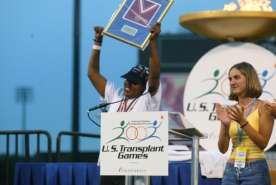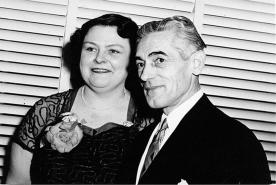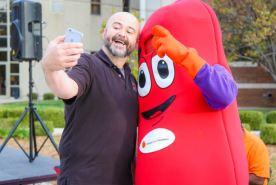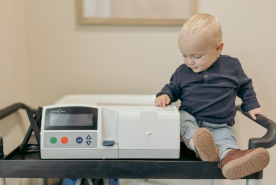Last updated: July 25, 2025
Medically reviewed by: NKF Patient Education Team
Content Created by: Melanie Betz MS, RD, CSR, FNKF, FAND
About Kidney Stone Treatment
A kidney stone is a hard lump made of minerals that can form in your kidneys and cause pain or trouble peeing. If you have a kidney stone, your doctor will talk with you about the best way to treat it. There are a few different options depending on the size, location, and symptoms you have. There are many possible paths or surgeries to treat kidney stones that have already formed:
- Wait for your kidney stone to pass
- Leave the kidney stone in your kidney
- Kidney stone removal surgery and procedures
- Ureteroscopy
- Extracorporeal Shock Wave Lithotripsy (ESWL)
- Percutaneous Nephrolithotomy
Wait for your kidney stone to pass
Most of the time, kidney stones can be passed through the ureter (YUR-uh-ter), the a thin tube that carries pee from your kidney to your bladder without surgery. Depending on the size of your kidney stone, where it is and type, your doctor may recommend that you try to pass the kidney stone.
Passing kidney stones is often painful. Your doctor can prescribe pain medications and offer advice to help you pass the kidney stone and manage pain.
Leave the kidney stone in your kidney
If a kidney stone is not causing pain or risk of kidney damage, it does not have to be removed. Depending on how big your kidney stone is and where it is, your doctor might suggest this option.
Your doctor will order ultrasounds, x-rays and/or CT scans of your kidneys every few months to a year to see if your kidney stones have changed size or moved. This helps your doctor make sure it is still safe not remove them.
Kidney stone removal surgery & procedures
There are many different surgeries and procedures to remove kidney stones. The right option for you depends on the type of stone you have, where it is, if it is causing pain and your body - as well as your preference. Your doctor will discuss all the options available to you.
Ureteroscopy
Ureteroscopy (yoo-REE-ter-OSS-kuh-pee ) is a procedure where a small tube is inserted into the bladder and kidneys through the urethra. It is used to diagnose and treat many different problems in the urinary tract and typically takes 1-2 hours.
Your doctor can remove kidney stones by putting a tiny wire basket into the tube, grabbing the kidney stone with the basket, and pulling it back through the tube and out of your body. Your doctor may also use a laser (shock wave lithotripsy) during a ureteroscopy to break up kidney stones to make them easier to remove.
Ureteroscopy is best for smaller stones. It has a greater chance of removing all of your kidney stone(s) compared to Extracorporeal Shock Wave Lithotrispy (ESWL).
Will I be hospitalized?
Most often, ureteroscopy is an outpatient procedure and does not require hospitalization. You will be put under general anesthesia for the procedure.
What are the risks?
There is a small chance of infection, bleeding, or injury to the ureter.
A stent, is a tiny tube that helps pee flow from your kidney to your bladder may be left in your ureter for one or two weeks after the procedure to help pass very small kidney stones leftover after the procedure and help your body heal.
What follow-up is needed?
Follow-up procedures are not usually needed to clear the stones completely. Imaging, like x-rays or CT scans are done to make sure all stones have been removed.
If a ureteral stent was required, you may also need to schedule a follow up appointment to remove it. Some people experience discomfort or pain with ureteral stents. Your doctor can order oral pain medication to help any discomfort
Most people can resume daily activities within a couple weeks.
Extracorporeal Shock Wave Lithotripsy (ESWL)
Extracorporeal (ek-struh-kor-PORE-ee-uhl) Shock Wave Lithotripsy (ESWL) is a non-invasive procedure to get rid of kidney stones. It uses high-energy shock waves to break stones into tiny fragments that can be more easily passed through urine.
ESWL works best for smaller kidney stones (less than 2 cm). ESWL may not be a good option for people with bleeding disorders, infections, severe skeletal abnormalities, or who are morbidly obese.
Will I be hospitalized?
Most often, ESWL is an outpatient procedure and does not require hospitalization. The procedure typically lasts 45-60 minutes. You and your doctor will discuss whether light sedation and local or general anesthetics will be used. Local, regional or general anesthesia is used to help you remain still and reduce any discomfort.
What are the risks?
Patients may experience some blood in their urine and discomfort as stone fragments pass.
What follow-up is needed?
Multiple sessions may be needed to clear your kidney stone(s) completely, and follow-up imaging is usually performed to make sure your kidney stones have been broken up enough and passed.
Most people can usually resume daily activities within one to two days. Drinking plenty of water helps pass the stone fragments, and oral pain medication can relieve any discomfort.
Percutaneous Nephrolithotomy (PCNL)
Percutaneous nephrolithotomy (PER-kyoo-TAY-nee-us nef-roh-lith-OT-oh-mee ) (PCNL) is minimally invasive surgery where your doctor will remove a kidney stone through a small incision in your back. Your surgeon will use a nephroscope (a miniature fiberoptic camera) and other small instruments threaded through the incision to either remove the kidney stone or use sound waves to break up the stone.
This surgery is typically used to remove very large kidney stones, irregularly shaped kidney stones or for people who cannot have an ureteroscopy or extracorporeal shock wave lithotripsy (ESWL).
Will I be hospitalized?
Yes. A PCNL requires general anesthesia. The surgery typically takes 2-4 hours. You will need a short (2 or 3 day) stay at the hospital. You may be off work for a week or so.
What are the risks?
The risks of PNCL include infection, bleeding, kidney damage, blood clots and other complications. Operations like a PCNL in the abdomen or belly carry a small risk of injury to other nearby organs, such as the bowel, the ureter, the liver or the bladder.
What follow-up is needed?
You will probably stay in the hospital 1-3 days after the PCNL so your doctor can monitor your healing and recovery. Follow up imaging will probably be done to make sure all of your kidney stones have been removed.
How to prevent kidney stones
If you have one kidney stone, you have up to a 75% chance of having another one in your lifetime. It is important to work with your doctor to come up with a personalized, kidney stone prevention plan for you.
Kidney stone prevention is different for everyone depending on your 24-hour urine collection and the type of kidney stone you have. Learn more about the prevention of calcium, uric acid, cystine and struvite kidney stones.
Questions for Your Healthcare Team
- What are all of my options to get rid of my kidney stones?
You should ask your doctor about ALL potential treatments for your kidney stones. - What are the risks and benefits of each option?
Knowing the risks and side effects helps you weigh the benefits against the potential drawbacks and prepares you for what to expect after treatment - Will I need additional treatments after the procedure?
Understanding that you might need multiple procedures to completely get rid of your kidney stones helps set realistic expectations – and allows you to plan for further medical care/discussion if needed - How should I prepare for the procedure?
Proper preparation can improve the effectiveness of your treatment and reduce the risk of complications, ensuring a smoother procedure and recovery.

















